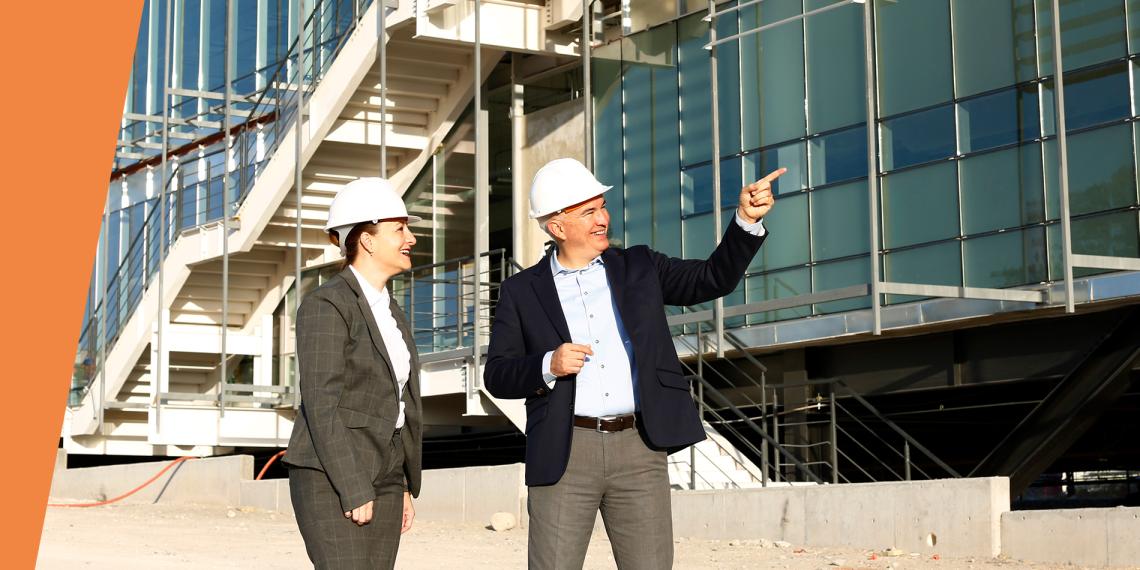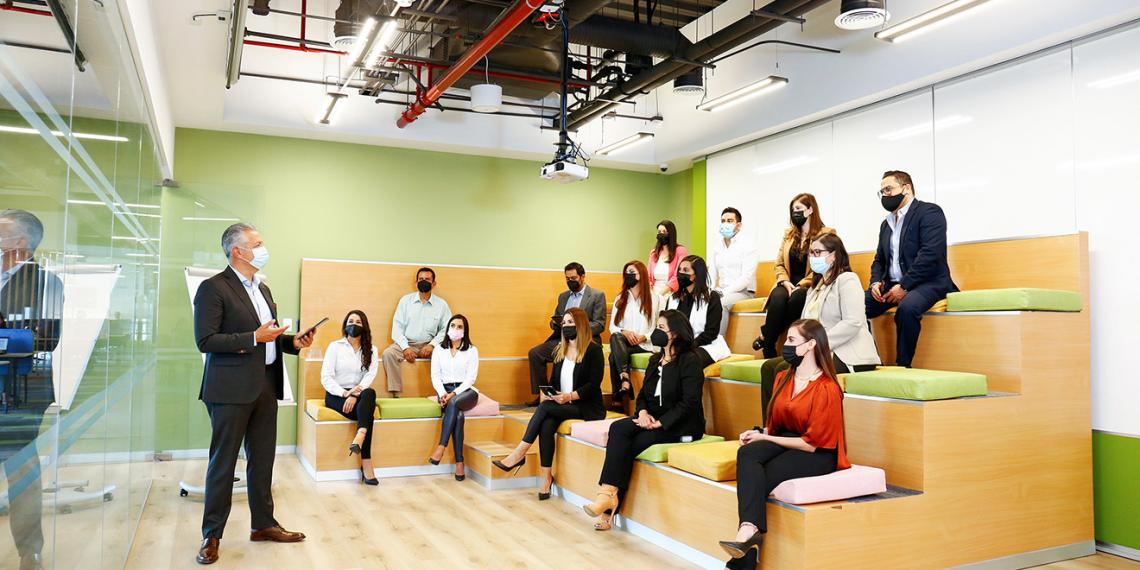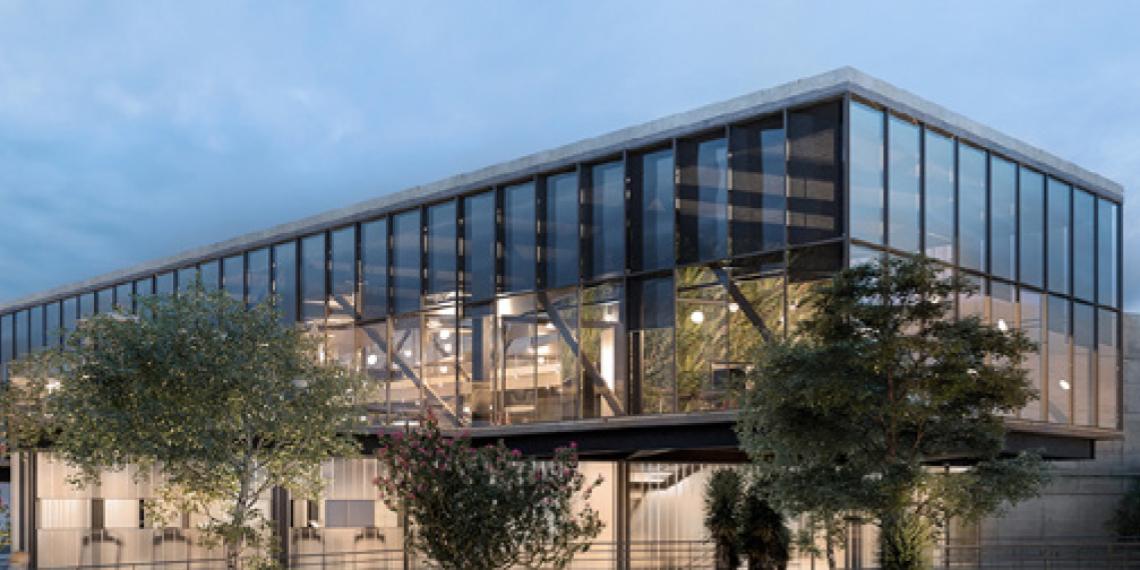Working sustainably
If the Group is to achieve its climate goals, it needs sustainable office buildings and working environments in particular. HDI Seguros is now focusing on ensuring a more agile organisation. And this in turn meant a move to a larger, more modern and more sustainable building. Especially as the old head office had become too small. “We decided to build a new headquarters that will allow staff to work in both an agile environment and a sustainable, certified building”, said Armando Prieto, Chief Financial Officer. The new head office will be opened in the third quarter of 2021.

Hilde Schulz, Human Talent Director, und Juan Ignacio González, CEO
A “green” office complex
After the decision had been taken to ensure that the new campus should be consistently sustainable and meet the latest environmental and technological requirements, HDI commissioned Oa2 Oxigeno-Architect and Design for the project. The specialist architects and designers had already implemented a number of sustainability projects that had been awarded EDGE certification in the past. HDI Seguros decided to seek EDGE certification because this prescribes the same sustainable procedures as the company already is already implementing. In addition, a related app provides the architects and building owners with the support and transparency they needed to construct a green, certified building that is both energy- and resource-friendly. The EDGE planning process is forecasting that the measures taken will result in energy and water savings of up to 20% each, plus savings of a further 20% in the energy needed to produce the materials used (this is known as “grey energy” or “embodied energy”). All in all, this would yield total savings for the three planned buildings of 117 t of CO2 per year. Joaquín Traslosheros, Finance Operations Director, commented as follows: “The EDGE tool convinced us that we have selected the right partner for our new headquarters. The team worked successfully to construct a new office complex that is clearly sustainable.”
To ensure the new building could deliver on the planned savings, the architects designed it to make optimum use of sunlight. This allows the solar cells on the roofs to generate electricity extremely efficiently. In addition, trees and other plants are being planted, creating a micro-environment that reduces the energy needed to cool the complex. Other sustainable design features include materials such as energy-efficient lighting systems and an air conditioning system that offers energy savings of up to 20%. The use of double-glazing for windows and reflecting colours for the façades add a further 20% to the building’s energy efficiency. Care is also being taken to ensure the efficient use of water during operations.
New ways of working

HDI Seguros had originally planned to move in at the end of 2020. However, building work had to be suspended during the first wave of the pandemic. And that wasn’t all: the coronavirus pandemic also led to new ways of working that raised questions about how staff would collaborate once it was over. The goal during the planning phase was not only to design a sustainable building but also to permit more agile cooperation.
Agility and digital transformation are critical focus issues for the Talanx Group’s continued long-term success. Additionally, a broad-based initiative aims to promote agile thinking and working and anchor them throughout the company for the long term. Agile organisations never stop learning and seek to be customer-centric in their work, improve their service offering and ensure profitable growth.
As a result, the pandemic raised new questions, such as whether it was necessary to rethink the working environment, since social distancing and the increased use of videoconferences for virtual meetings have become the new normal. Should the workplaces in the new headquarters building be adapted to produce hybrid working environments featuring fewer people in each room and greater digital connectivity? The answer was a resounding “yes”. The reassessment has led to more closed rooms for online meetings being added to the planning. In addition, dedicated teamworking spaces and break rooms are vital for the new way of working, since they increase agility.
These new working methods also require more technology in the rooms so that staff can network with colleagues located remotely. Hilde Schulz, Human Talent Director: “In the spirit of agility, we rapidly adapted the plans to reflect the new hybrid way of working.” Half of the workplaces and meeting rooms will be equipped with permanent monitors and a variety of connectivity options. This will make what was already an attractive new building for employees even more interesting. In addition to enhancing agility, the new complex also reflects the radical change in working methods. As a result, modifying the planning led to an investment in the company’s sustainable future.
EDGE certification

EDGE stands for “Excellence in Design for Greater Efficiencies”. The certification programme was launched in 2014. EDGE supports the planning and certification of resource-friendly, carbon-neutral buildings. The organisation helps construction companies, commercial property owners and investors with their planning by providing an app offering a standard for environmentally-friendly buildings, a software application and certification in more than 170 countries. Using the EDGE app can cut water and resource consumption by at least 20%. There are three certification levels. Level 1 is reached if energy, water and embodied energy savings of 20% or more are achieved. Level 2 applies to on-site energy savings of at least 40%. Level 3 is awarded to sites that use 100% renewable energy or purchase carbon offsets to top off at 100%. EDGE certification has saved 274,750 t of carbon emissions per year to date.
For further information see https://edgebuildings.com